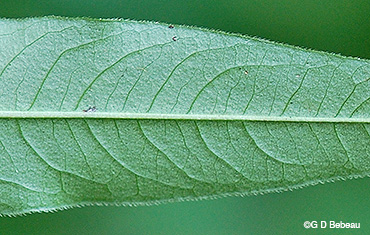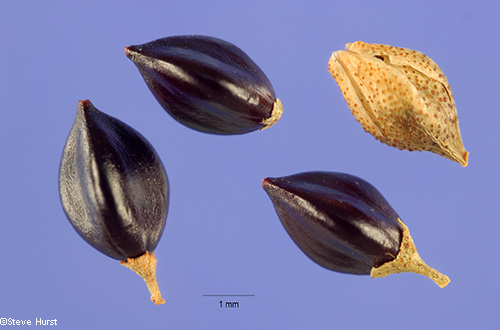The Friends of the Wildflower Garden, Inc.
Plants of the Eloise Butler Wildflower Garden
The oldest public wildflower garden in the United States

Common Name
Dotted Smartweed (Water Knotweed)
Scientific Name
Persicaria punctata (Elliott) Small
Plant Family
Buckwheat (Polygonaceae)
Garden Location
Wetland
Prime Season
Late Summer to Early Autumn
Dotted Smartweed is a native erect to sprawling annual or short-lived perennial forb, growing in aquatic to terrestrial environments on smooth stems, without noticeable ribs, to 40 inches high. Stems enlarge where the leaf sheath joins.
The leaves are alternate, narrowly lance-like, almost 8x longer than wide, usually with smooth surfaces, no surface blotches, margins are not toothed, but have stiff appressed bristles curving toward the tip (antrorse). Tips are pointed, bases taper to short stalks (some upper leaves may be stalkless) with a sheath (an ocrea) at the stem that is cylindric with bristles at the edges. The ocrea has somewhat of a brown color at the joint with the stem where the stem node is a bit enlarged.
The inflorescence is a thin interrupted spike-like raceme, 2 to 6 inches long, at the top of stems, with an occasional axillary spike. The base of the spike stem has a sheath (an ocreolae) that has bristles.
Flowers occur in fascicles of 2 to 6, with groups of fascicles dispersed along the raceme with interruptions. The flowers are about 1/8 inch long with a perianth green at the base and white at the top, rarely with pink, with 5 tepals (combined sepals and petals) folded against each other and connected for 1/3 of their length. Tepals may or may not have visible veins, but if so, they are NOT anchor shaped; margins are entire. There are 6 to 8 stamens with pink to red anthers, and 2 to 3 styles, connected at their bases. The perianth has very small glandular dots and has a short stalk.
Seeds: Fertile flowers produce a dry smooth brown to black 3 sided achene that is wind dispersed.
Habitat: Dotted Smartweed grows in moist marshes, swamps and wet rich stream-sides, doing best with full sun, but will flower with partial sun but then tends to sprawl. It grows from either small rhizomes or roots form from the lower stem nodes.
Names: The genus Persicaria is from the Latin and meaning 'peach-like', which was a name applied a millennium ago to Knotweeds (Smartweeds); it is derived from persica for 'peach' and aria, meaning 'pertaining to', and thought to be referring to the leaves being similar to one of the peaches. The species, punctata, is from the Latin meaning 'dotted' and refers to the dotted glands of the flowers. The genus Polygonum has recently been divided into several genera, one of which is Persicaria. This species was formerly classified as Polygonum punctatum. See more notes below. The author names for the plant classification are as follows: First to classify was ‘Elliot’ which refers to Stephen Elliot (1771-1830) American botanist and collector whose herbarium was the largest in America at the time. He is noted for A Sketch of the Botany of South Carolina and Georgia. His work was updated by ‘Small’ which refers to John Kunkel Small (1869-1938), American Botanist, first curator of the New York Botanical Garden, best known for Flora of the Southeastern United States.
Comparisons: Another Smartweed without the blotch on the leaf and which also grows in a more wet environment is Water Smartweed - Persicaria amphibia (L.) Gray, but it has rose to red flowers. Another that likes moisture but not in water is Spotted Lady's-thumb, Persicaria maculosa Gray. The leaves there have a distinctive dark triangular blotch and the flowers are whitish-pink. Very similar, but with spikes that are not interrupted but nod instead, is Pale Smartweed, P. lapathifolia.

Above: The inflorescence is a thin interrupted spike-like raceme.
Below: 1st photo - Flowers are dispersed in small groups along the raceme. The flowers are about 1/8" long with a perianth green at the base and white at the top, rarely with pink, with the 5 tepals folded against each other. 2nd photo - Leaves join with a sheath (an ocrea) at the stem, bristles at the edges, somewhat of a brown color at the joint with the node a bit enlarged.


Below: Leaves usually have smooth surfaces, no surface blotches, margins are not toothed, but have stiff appressed antrorse bristles (2nd photo). Tips are pointed, bases taper to short stalks. 2nd photo shows the paler color leaf underside.


Below: Three images of inflorescence detail.



Below: A section of the inflorescence showing the glandular dotting on the perianth of the flowers.

Below: The brownish-black achenes, 3 angled. Note the dry gland dots on the example of the seed with tepals still attached. Photo courtesy Steve Hurst, USDA-NRCS Plants Database.

Notes: Dotted Smartweed is not considered indigenous to the Garden, but it has been in the Garden wetland for some years. It is found in most of North America except for the far north Canadian Provinces, Alberta, Labrador and Newfoundland. In Minnesota it is present in the majority of counties, most exceptions being in the drier SW. It is one of 12 species of Persicaria in Minnesota, 3 are introduced, 9 are native, and all but two are found in Hennepin County and one of those two, Persicaria careyi, is on the Special Concern list as it was last collected in 1940.
Classification: The genus Polygonum has recently been divided into several genera, one of which is Persicaria. Dotted Smartweed has had a number of previous scientific classifications, the most general being Polygonum punctatum Elliott, which had a large number (12) of varieties associated with it. Some of the important authorities today, such as Flora of North America, refuse to recognize these older names and varieties and considered all the differences simply widespread variances of the same genus and species. Both the U of M Herbarium and the MN DNR listings follow that line of reasoning. USDA still lists several of the varieties (2019).
Return to -- Site Plan/Archive Index --or-- List of Common Plant Names -- or -- List of Scientific Names -- or --Home Page - - - Back to top.
References: Plant characteristics are generally from sources 1A, 32, W2, W3, W7 & W8 plus others as specifically applied. Distribution principally from W1, W2 and 28C. Planting history generally from 1, 4 & 4a. Other sources by specific reference. See Reference List for details.
 Identification booklet for most of the flowering forbs and small flowering shrubs of the Eloise Butler Wildflower Garden. Details Here.
Identification booklet for most of the flowering forbs and small flowering shrubs of the Eloise Butler Wildflower Garden. Details Here.
©2013
Friends of the Wildflower Garden, Inc. Text and photos are by G. D. Bebeau unless otherwise credited. "www.friendsofeloisebutler.org"
041720